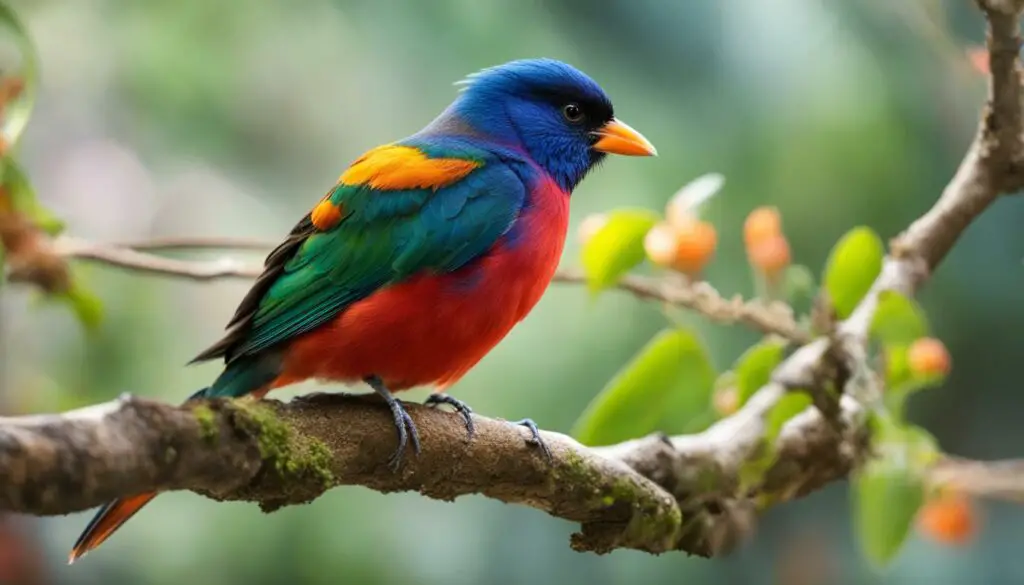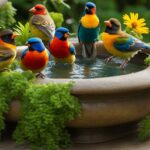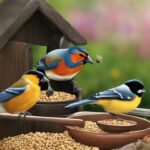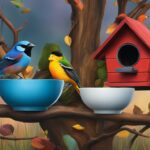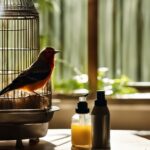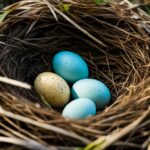As a bird owner, choosing the right perch size is essential to ensure the comfort and safety of your feathered friend. Birds rely on perches for standing, climbing, playing, and engaging in natural behaviors. By selecting the optimal perch size, you can create an environment that promotes their overall well-being.
When it comes to perch sizing, it’s important to consider the bird’s size and preferences. The diameter of the perch should match the bird’s size, allowing them to wrap their toes around it for a secure grip. Varying perch sizes within the bird’s cage also provide exercise opportunities and prevent sore feet.
There are different types of perches available, each with its own advantages and considerations. Wood branches, such as natural manzanita perches, provide a more natural feel and allow birds to experience varying diameters. Rope perches offer a softer surface for gripping and chewing. Ceramic or cement perches can be used for beak and nail maintenance. Plastic perches are sturdy and easy to clean.
To help you choose the right perch size, this guide provides recommendations for different bird species. It also highlights the importance of maintaining hygiene by regularly cleaning perches. With these tips, you can create a comfortable and stimulating environment for your feathered companion.
Key Takeaways:
- Choosing the right perch size is crucial for the comfort and safety of your bird.
- Perch diameter should match the bird’s size for a secure grip.
- Varying perch sizes provide exercise opportunities and prevent foot problems.
- Wood branches, rope perches, ceramic or cement perches, and plastic perches offer unique advantages.
- Regular perch cleaning maintains hygiene and prevents health issues.
The Importance of Perches for Birds
Perches play a crucial role in the lives of birds, providing them with numerous benefits and supporting their overall well-being. As birds spend a significant amount of time standing, perches serve as a place for them to rest, exercise, and engage in natural behaviors. Having the right perch size and variety is essential to ensure their comfort and prevent foot problems.
One of the key benefits of perches is that they provide exercise opportunities for birds. By climbing and moving around different perches of varying sizes and textures, birds can strengthen their muscles and maintain their physical health. Perches also allow birds to engage in natural activities like chewing, rubbing their beaks, and cleaning their feathers, promoting mental stimulation and enrichment.
Providing a variety of perch types made from different materials and textures further enhances the benefits for birds. Wood branches offer a natural and rustic feel, while rope perches provide a softer surface for gripping and chewing. Ceramic or cement perches can contribute to beak and nail maintenance. It’s important to offer a combination of perches to cater to the different needs and preferences of the birds in your care.
| Benefits of Perches for Birds: |
|---|
| Exercise opportunities for strengthening muscles |
| Engagement in natural behaviors like chewing and rubbing beaks |
| Mental stimulation and enrichment |
| Support for beak and nail maintenance |
“Birds enjoy perches because they mimic their natural habitats and allow them to feel secure and in control of their environment.” – Avian Expert
Overall, perches are not just accessories in a bird’s cage but essential components that contribute to their physical and mental well-being. By providing the right perches and maintaining a clean and hygienic environment, you can create a comfortable and enriching space for your feathered friends to thrive.
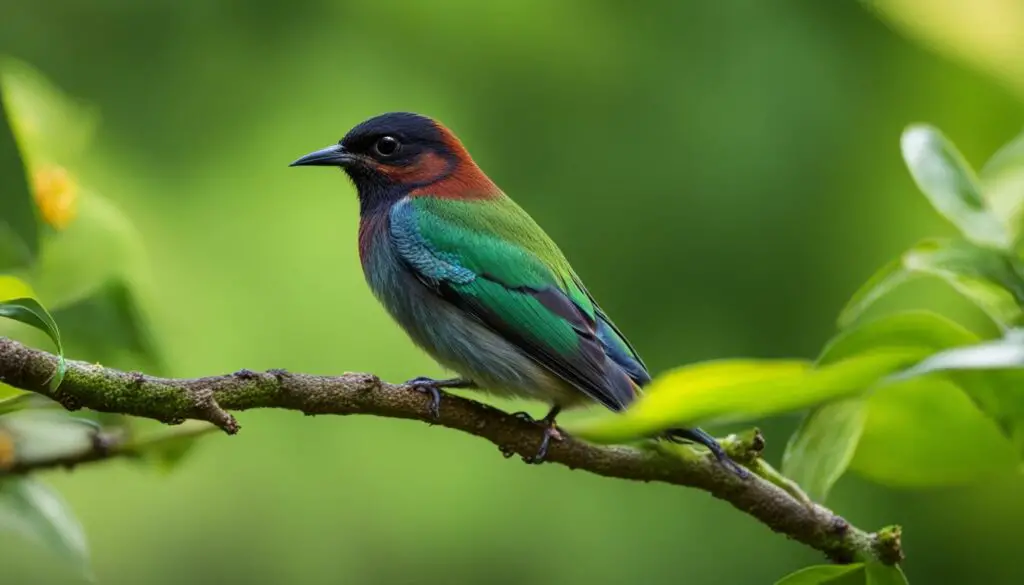
Choosing the Right Perch Types
When it comes to selecting perches for your bird, it’s important to consider the different types available. Each type of perch offers unique advantages and considerations, ensuring your bird’s comfort and well-being. Here are some popular perch options:
Wood Branches as Perches
Wood branches make excellent perches as they provide varying diameters, allowing birds to distribute pressure on their feet. Manzanita wood perches are commercially available, or you can use branches from non-toxic trees such as apple, elm, ash, maple, or willow, after washing and disinfecting them. These natural perches mimic the texture and feel of branches in the wild, providing a closer-to-nature experience for your bird.
Rope Perches
Rope perches made of hemp or untreated cotton provide a softer surface for gripping and chewing. The textured material enhances grip and gives birds a more comfortable perch to rest on. These perches come in various lengths and can be twisted to create different shapes, adding versatility to your bird’s environment.
Ceramic and Cement Perches
Ceramic or cement perches can be used for beak and nail maintenance. These perches are abrasive and help to naturally wear down the bird’s beak and claws, promoting healthy growth. However, it’s important to note that ceramic or cement perches should not be the only perches in the cage, as they lack the variation in diameter and texture necessary for proper foot health.
Plastic Perches
Plastic perches are sturdy, easy to clean, and come in various sizes and shapes. However, they may be slippery and lack texture, making it harder for birds to grip. It’s essential to monitor your bird’s comfort and foot condition when using plastic perches and provide additional perches with varying textures to ensure their well-being.
By offering a variety of perch types, you can create a stimulating and comfortable environment for your feathered friend. It’s important to observe your bird’s preferences and monitor their foot health to ensure they have the ideal perches for their needs.
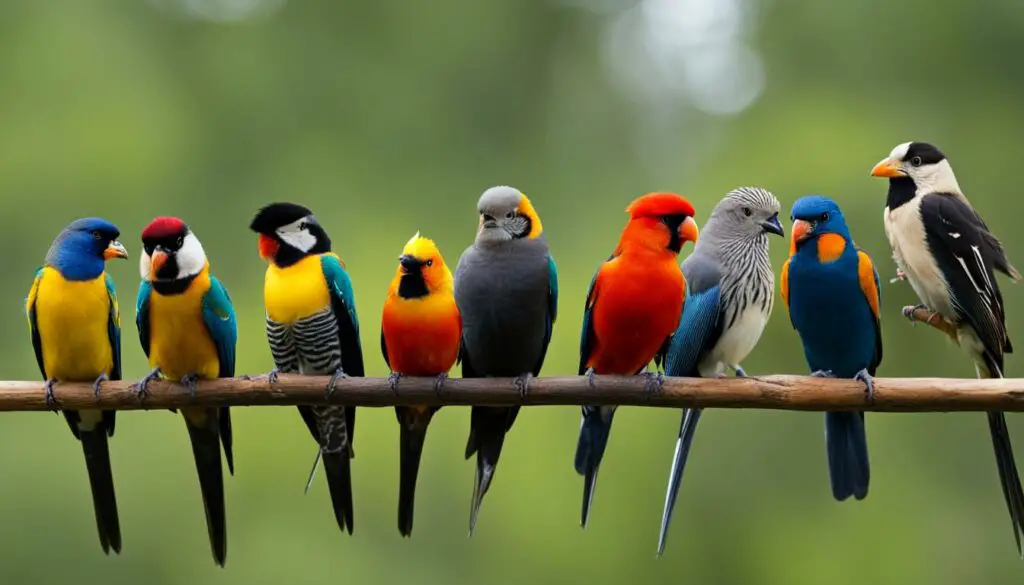
As the table above illustrates, the different types of perches vary in terms of their advantages and considerations. Choose the right perch type that best suits your bird’s needs, taking into account their comfort, foot health, and overall well-being. Remember to provide a variety of perch options, incorporating different textures and materials, to offer a stimulating and enriching environment for your feathered friend.
Perch Size for Parakeets
When it comes to choosing the right perch size for your parakeets, it’s important to consider their comfort and safety. Parakeets spend a significant amount of time perching, so providing the optimal perch diameter is crucial. Thin branches with a diameter of no more than half an inch are ideal for small cages, as they allow the parakeets to wrap their toes around for a secure grip. For larger cages, thicker branches can be used to accommodate their size.
Varying perch sizes is also beneficial for parakeets as it provides them with a variety of textures and exercise opportunities. Different diameters help exercise their feet and prevent pressure sores. By offering a range of perch sizes, you can ensure that your parakeets have a stimulating and comfortable environment to thrive in.
To summarize, the optimal perch diameter for parakeets should be no more than half an inch for small cages, while larger cages can accommodate thicker branches. Varying perch sizes provides exercise opportunities and prevents foot problems. By selecting the right perch size, you can create a comfortable environment that promotes the well-being of your parakeets.
The Impact of Perches on Bird Health
Providing appropriate perches for birds is not just about creating a comfortable space for them, but it also has a significant impact on their overall health. The size and design of perches can affect the well-being of a bird’s feet, as well as help prevent foot problems.
When birds are provided with a single straight rod perch, they may be at risk of developing arthritis as they age. This is because standing on a flat surface for extended periods can cause strain on their joints. By offering perches of varying diameters, birds can exercise their feet and distribute pressure more evenly, reducing the likelihood of developing foot issues.
One important consideration is the diameter of the perch. Birds should have at least one perch that allows their toes to wrap around two-thirds of its diameter. This allows for a secure grip and promotes natural foot movement. Varying perch sizes and textures also provide stimulation and exercise for their feet.
| Effects of Perches on Bird Feet | Foot Problems in Birds |
|---|---|
|
|
“The proper perch size and variety are essential for maintaining optimal bird foot health. By providing perches of different sizes and materials, bird owners can help prevent foot problems and ensure their feathered friends’ well-being.”
It is crucial for bird owners to regularly check their perches for any signs of wear or damage. Broken or abrasive perches should be replaced promptly to avoid potential injuries. Additionally, maintaining proper hygiene by regularly cleaning perches helps reduce the risk of infections and promotes a healthy living environment for birds.
Overall, the impact of perches on bird health cannot be overstated. By selecting suitable perch sizes and materials, bird owners can contribute to their pets’ physical well-being and ensure they lead comfortable, healthy lives.
Perch Size Guidelines for Different Bird Species
Choosing the right perch size is crucial for ensuring the comfort and safety of your feathered friend. Different bird species have varying perch size requirements to accommodate their unique needs. Here are some perch size guidelines for common bird species:
American Finch (3/8″ – 1/2″)
American Finches, also known as House Finches, thrive on perches with a diameter range of 3/8″ to 1/2″. These small birds prefer perches on the thinner side for a secure grip. Providing varying diameter perches within this range will offer exercise opportunities and prevent foot discomfort.
Budgerigar (3/8″ – 1/2″)
Budgerigars, or Budgies, also enjoy perches with a diameter range of 3/8″ to 1/2″. These popular pet birds need smaller perches that allow them to wrap their toes comfortably. Incorporating different perch textures within this size range will provide mental stimulation and promote their natural behaviors.
Cockatiel (1/2″ – 5/8″)
Cockatiels thrive on perches with a diameter range of 1/2″ to 5/8″. These medium-sized birds benefit from perches that are slightly thicker, allowing them to exercise their feet and maintain proper foot health. Offering a variety of perch materials within this size range will keep them engaged and entertained.
Macaw (3/4″ – 2-1/2″)
Macaws, large and majestic birds, require perches with a diameter range of 3/4″ to 2-1/2″. These powerful birds need thicker perches to support their weight and provide ample grip for their large feet. Including perches of different materials and textures within this size range will keep them mentally stimulated and prevent foot problems.
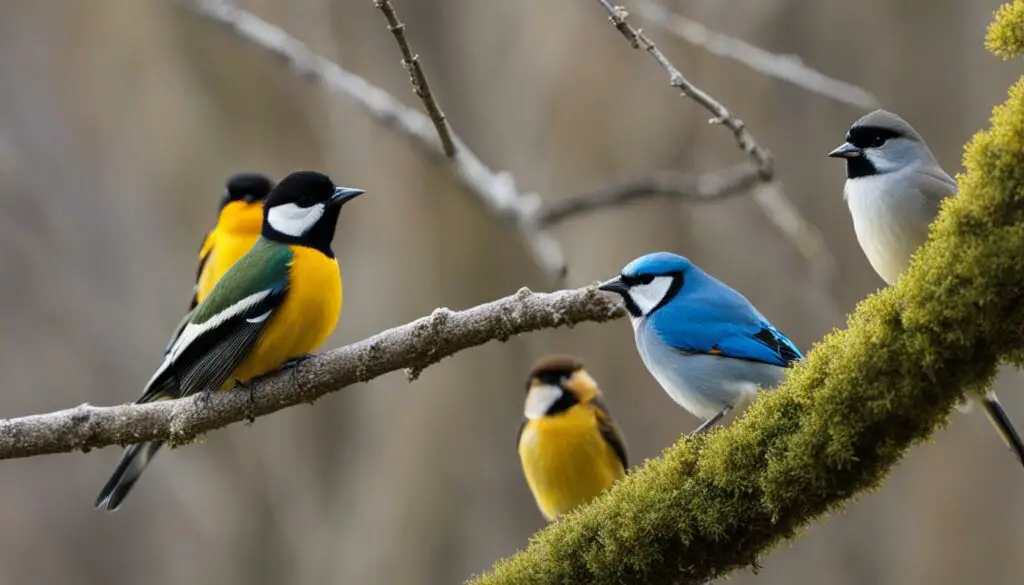
Conclusion
When selecting perches for your bird, it’s crucial to consider their species-specific perch size requirements. Providing the right perch size ensures their comfort, promotes exercise, and prevents foot problems. By following these perch size guidelines, you can create an ideal environment for your feathered companion to thrive.
Cleaning Bird Perches: Maintaining Perch Hygiene
Keeping your bird’s perches clean is crucial for their health and well-being. Regular cleaning helps prevent the buildup of bacteria, mold, and unpleasant odors. The frequency of perch cleaning depends on how dirty they become, but as a general guideline, it is recommended to clean perches at least once a week.
To clean your bird’s perches, start by removing them from the cage. Scrub the perches with warm water and a mild detergent or a bird-safe disinfectant. Pay special attention to any areas where food or droppings may have accumulated. Rinse the perches thoroughly to remove any residue, ensuring they are completely clean before placing them back in the cage.
While cleaning, it’s important to inspect the perches for any signs of wear or damage. Broken or splintered perches can be hazardous to your bird, so be sure to replace any perches that are in poor condition. Additionally, consider providing multiple perches of varying sizes and textures to give your bird options and promote foot health.
Table: Recommended Frequency of Perch Cleaning
| Type of Perch | Recommended Cleaning Frequency |
|---|---|
| Wood branches | Once a week |
| Rope perches | Once every two weeks |
| Ceramic or cement perches | Once every two weeks |
| Plastic perches | Once every two weeks |
In addition to regular cleaning, it’s important to keep an eye on your bird’s perches for signs of contamination or damage between cleanings. If you notice any droppings or food particles on the perches, remove them promptly to maintain a clean and hygienic environment for your feathered friend.
By prioritizing perch hygiene and cleaning your bird’s perches regularly, you are creating a clean and safe environment that promotes your bird’s overall health and well-being.
Safe Trees for Perches
When it comes to providing perches for your feathered friends, it’s essential to choose safe and non-toxic tree branches. Certain types of trees can be used to create perches that are both functional and visually appealing in bird cages. Here are some examples of safe trees:
- Apple
- Elm
- Ash
- Maple
- Willow
These tree branches can be used to create natural perches for birds, allowing them to engage in their natural behaviors. However, it’s important to note that before using these branches, they should be thoroughly washed and disinfected to remove any potential microscopic fungus or insects that may be harmful to birds. A good way to eliminate these risks is by heating the branches in an oven at 200°F for 30 minutes.
By incorporating safe tree branches as perches, you not only provide birds with a comfortable place to stand and play but also add a touch of nature to their environment. Natural perches not only contribute to the overall well-being of birds but also enhance the aesthetics of their living space.
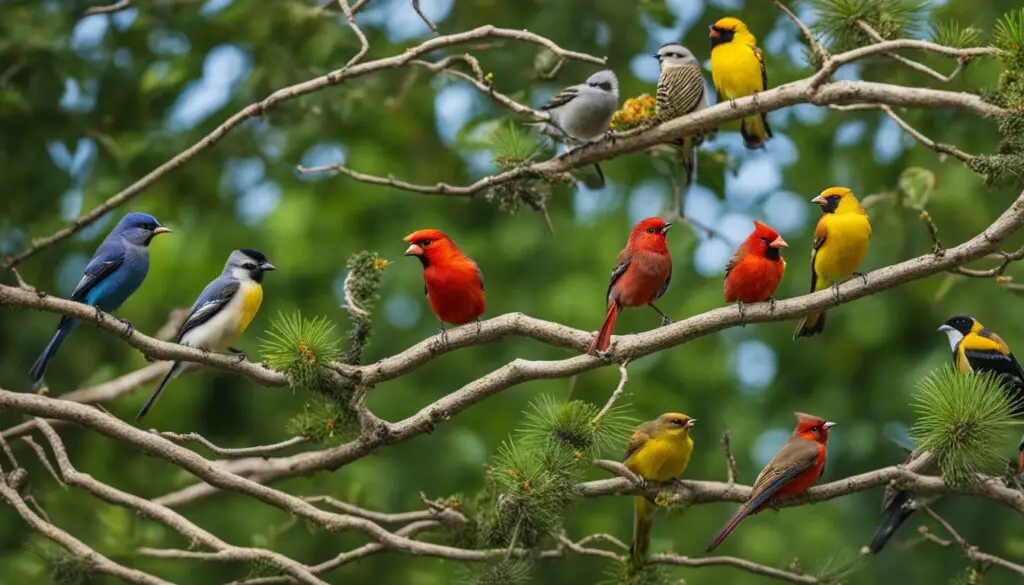
Table: Safe Trees for Perches
| Tree | Branch Size |
|---|---|
| Apple | Varying diameters |
| Elm | Varying diameters |
| Ash | Varying diameters |
| Maple | Varying diameters |
| Willow | Varying diameters |
The Dangers of Sandpaper Perches
When it comes to providing perches for birds, it is important to consider their safety and well-being. One type of perch that should be avoided is the sandpaper perch. While these perches may seem convenient for trimming bird nails, they can actually be quite harmful to our feathered friends.
The rough texture of sandpaper can cause irritation and sores on the bottom of a bird’s feet. Birds have delicate skin on their feet, and the constant rubbing against the sandpaper can lead to discomfort and even injury. It is best to choose alternative perch options that provide grip and comfort without causing harm to the bird.
“Sandpaper perches can cause irritation and sores on the bottom of a bird’s feet.”
There are many other safe and effective options for maintaining bird nails, such as using ceramic or cement perches. These perches provide texture for beak and nail maintenance without the risk of injury. However, it is important to note that ceramic or cement perches should not be the only perches used in a bird cage, as they do not offer the same variety and exercise opportunities as natural wood or rope perches.
| Perch Type | Advantages | Disadvantages |
|---|---|---|
| Natural Wood/Branch Perches | Offers varying diameters for foot exercise | Requires regular cleaning and disinfecting |
| Rope Perches | Soft surface for gripping and chewing | Can become frayed and pose entanglement risks |
| Ceramic/Cement Perches | Provides texture for beak and nail maintenance | Should not be the only perch in the cage |
| Plastic Perches | Sturdy and easy to clean | May be slippery and lack texture for gripping |
By avoiding sandpaper perches and selecting safe alternatives, we can ensure that our birds are comfortable and free from any unnecessary harm. It is always important to prioritize their well-being and provide them with perches that promote natural behaviors and support their overall health.
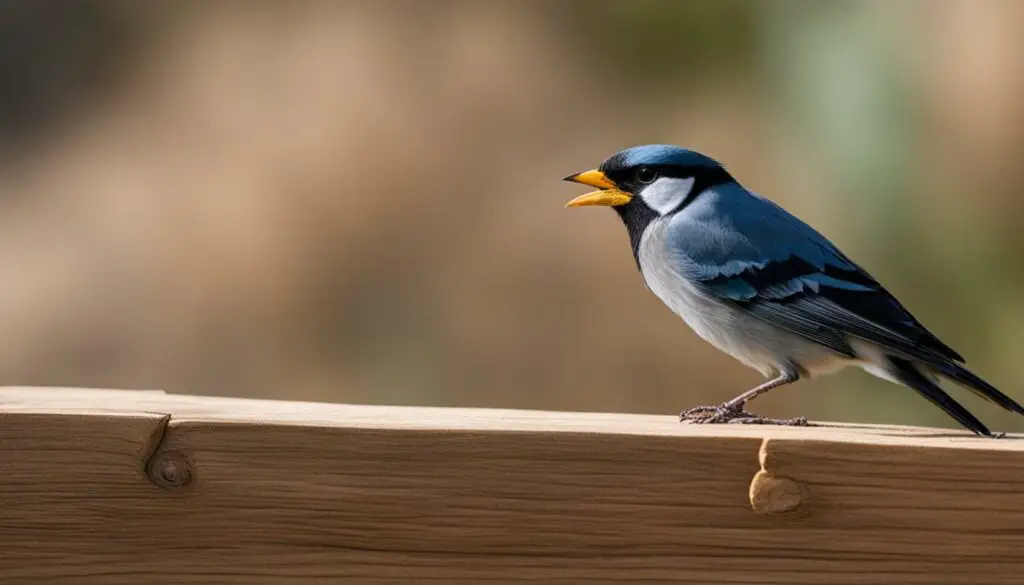
The Importance of Texture in Perches
Texture plays a crucial role in bird perches. Providing a variety of textures can enhance the bird’s experience and contribute to their overall well-being. Rough-textured perches, such as those made of wood or twisted twigs, provide a good grip for birds and allow them to engage in natural behaviors like chewing. Smooth perches, such as plastic perches, may be less ideal as they can be slippery and offer less texture for gripping.
By incorporating perches with different textures, bird owners can provide their feathered friends with mental stimulation and enrichment. Birds enjoy exploring and experiencing new textures, and textured perches can offer a more natural and engaging environment for them. The rough surface of wood perches also helps wear down the bird’s nails naturally, reducing the need for frequent nail trims.
To ensure the well-being of birds, it is important to consider the benefits of textured perches when selecting perches for their cages. Providing a variety of textures, such as wood, rope, and natural materials, can help mimic the bird’s natural habitat and promote their overall health and happiness. Remember to regularly inspect and clean textured perches to maintain hygiene and prevent any potential hazards.
| Perch Type | Texture | Benefits |
|---|---|---|
| Wood Perches | Rough | Provides a good grip and natural texture for chewing |
| Rope Perches | Soft and twisted | Offers a comfortable surface for gripping and chewing |
| Manzanita Perches | Irregular and rough | Provides varied textures and helps naturally wear down nails |
| Plastic Perches | Smooth | May be slippery and offer less texture for gripping |
Caring for Rope Perches
When it comes to caring for bird rope perches, there are a few things to keep in mind to ensure the safety and well-being of your feathered friend. Rope perches made of natural hemp or untreated cotton can provide a softer surface for gripping and chewing. However, they require careful monitoring and maintenance to prevent potential hazards.
One potential hazard is the risk of fraying or tattering of the rope perch. Birds may chew on the rope, causing it to become worn out and potentially entangling their toes. Regularly inspect the rope perch for any signs of damage and replace it if necessary to prevent accidents and injuries.
Another important aspect of caring for rope perches is cleanliness. Like other types of perches, rope perches can become dirty over time due to droppings or food debris. To clean a rope perch, you can wash it in the washing machine or dishwasher, using a mild detergent. Make sure to thoroughly rinse and dry the perch before returning it to the bird’s cage.
Important Points to Remember:
- Regularly inspect rope perches for signs of damage, such as fraying or tattering.
- Replace the rope perch if it becomes worn out to prevent accidents and injuries.
- Clean rope perches regularly to maintain hygiene, using a mild detergent and thorough rinsing.
- Dry the rope perch completely before placing it back in the bird’s cage.
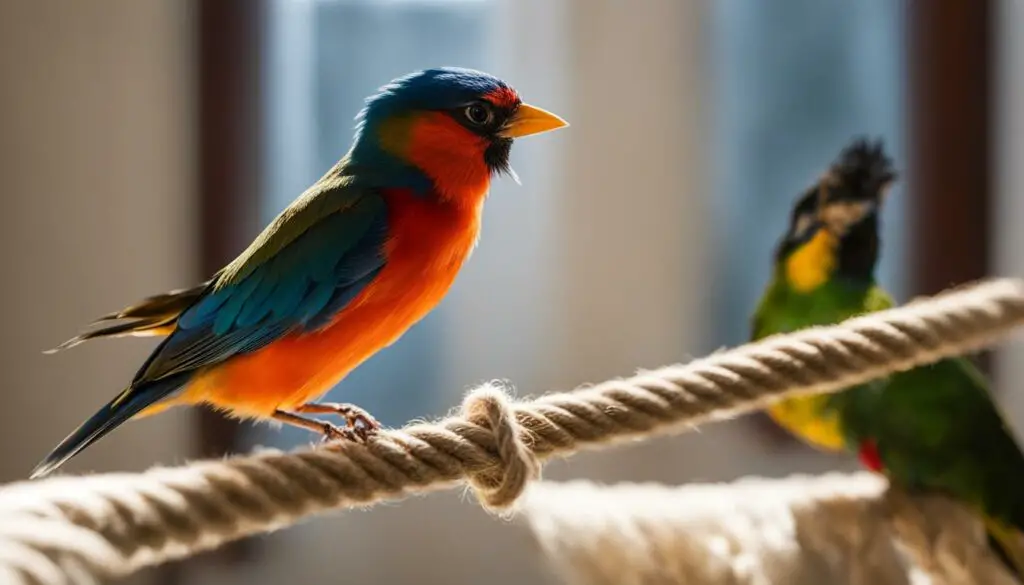
In Summary
Caring for bird rope perches involves monitoring their condition, ensuring they are free of damage, and maintaining cleanliness. By following these guidelines, you can provide a safe and comfortable environment for your bird, allowing them to enjoy the benefits of a rope perch without unnecessary risks.
Perch Options for Beak and Nail Maintenance
When it comes to maintaining the health and well-being of our feathered friends, providing the right perch options for beak and nail maintenance is essential. Ceramic and cement perches offer unique benefits in this regard. These specialized perches not only provide a textured surface for birds to groom their beaks and nails but also contribute to their overall physical and mental stimulation.
Ceramic perches, also known as pumice perches, have a rough surface that helps naturally wear down a bird’s beak and nails. Placing a ceramic perch near the bird’s food bowl encourages them to clean their beaks while eating, promoting good oral hygiene. It is important to monitor the condition of ceramic perches and replace them if they become abrasive or worn out.
Cement perches, on the other hand, are made from a mixture of cement and sand, providing a slightly abrasive texture. This helps to keep the nails of birds in check, preventing overgrowth and potential problems. However, it is important to note that ceramic and cement perches should not be the only perches in the cage. Birds should have a variety of perches with different textures and diameters to ensure foot health and prevent any discomfort.
Benefits of Textured Perches
Textured perches, such as ceramic and cement perches, offer several benefits for our avian companions. The rough surface of these perches mimics natural environments, providing stimulation and exercise for a bird’s feet. This can help prevent foot problems and foot muscle atrophy, ensuring optimal foot health and overall well-being.
In addition to their functional benefits, textured perches also offer mental stimulation and enrichment. Birds enjoy exploring different textures, and the rough surface of ceramic and cement perches provides them with an engaging and interactive experience. This can help alleviate boredom and promote natural behaviors, enhancing the quality of life for our feathered friends.
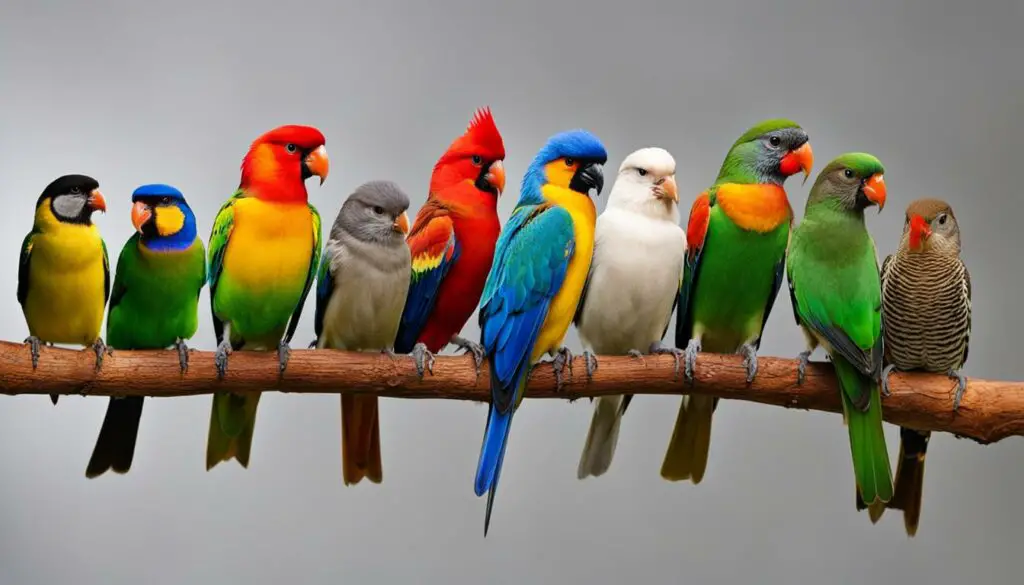
Table: Types of Perches for Beak and Nail Maintenance
| Type of Perch | Material | Texture | Benefits |
|---|---|---|---|
| Ceramic Perches | Ceramic | Rough | Promotes beak grooming, encourages oral hygiene |
| Cement Perches | Cement and sand mixture | Abrasive | Helps maintain nail length, prevents overgrowth |
Conclusion
When it comes to creating a comfortable environment for birds, choosing the right perch size is of utmost importance. By following the recommended bird perch size guidelines, you can ensure that your feathered friends have perches that are suitable for their size, allowing them to securely grip and maintain their balance. This not only promotes their comfort but also prevents foot problems and promotes overall bird health.
Aside from perch size, it is essential to provide a variety of perch types to meet different needs and preferences. Wood branches, such as manzanita or branches from non-toxic trees, offer a natural and varied texture that birds can enjoy. Rope perches provide a softer and chewable surface, while ceramic or cement perches assist with beak and nail maintenance. By offering a range of perches, you can ensure that your birds have opportunities for exercise, mental stimulation, and natural behaviors.
Another crucial aspect of bird perch care is maintaining proper hygiene. Regularly cleaning perches helps eliminate built-up dirt, food particles, and feces, ensuring a clean and healthy environment for your birds. Additionally, monitoring the condition of perches, such as checking for wear and tear or tattered ropes, helps prevent potential hazards that may harm your birds.
In conclusion, by following bird perch size recommendations, providing a comfortable and stimulating perch variety, and maintaining proper hygiene, you can create an ideal environment for your birds. Remember, the well-being of your feathery companions depends on the right perch choices, so take the time to choose wisely and give your birds the perches they need to thrive.
FAQ
Why are perches important for birds?
Perches provide a place for birds to stand, climb, play, and engage in natural behaviors. They also offer exercise opportunities and help prevent foot problems.
What types of perches can I choose from?
There are various types of perches available, including wood branches, rope perches, ceramic or cement perches, and plastic perches.
How do I choose the right perch size for my bird?
The perch diameter should match the bird’s size, allowing them to wrap their toes around it for a secure grip. Varying perch sizes provide exercise opportunities and prevent foot soreness.
How often should I clean my bird’s perches?
Perches should be cleaned regularly to maintain hygiene. The frequency of cleaning depends on how dirty they become, and it is important to monitor and clean the perches as needed.
Can I use tree branches as perches for my bird?
Yes, certain non-toxic tree branches like apple, elm, ash, maple, and willow can be used as perches after washing and disinfecting them.
Are sandpaper perches safe for birds?
No, sandpaper perch covers are not recommended as they can cause irritation and sores on the bird’s feet. It is best to choose alternative perch options.
Why is texture important in bird perches?
Perches with rough textures, like wood or twisted twigs, provide a good grip for birds and allow them to engage in natural behaviors. Smooth perches may be slippery and offer less texture for gripping.
How do I care for rope perches?
Rope perches require careful monitoring and maintenance as birds may chew on them. When dirty, they can be cleaned in the washing machine or dishwasher.
Can I use ceramic or cement perches for my bird?
Yes, ceramic or cement perches can be used in conjunction with other perches to provide texture for beak and nail maintenance. However, they should not be the only perches used in cages.
What are the perch size guidelines for different bird species?
The ideal perch size varies depending on the bird species. Different species require perches with varying diameters to ensure their comfort and safety. Consult size guidelines provided by experts for specific recommendations.
How does perch size affect parakeets?
Parakeets require perches with a diameter that allows them to wrap their toes around two-thirds of its diameter. Providing varying perch sizes and textures is essential for their comfort and exercise.
Source Links
- https://blog.birdcages4less.com/the-april-perch-series-the-importance-of-perch-diameter/
- https://vcahospitals.com/know-your-pet/perches-for-birds
- https://www.omlet.us/guide/parakeets/perches_for_cages/

